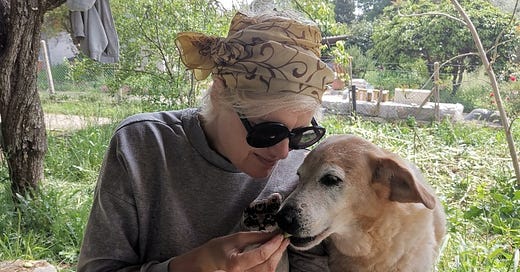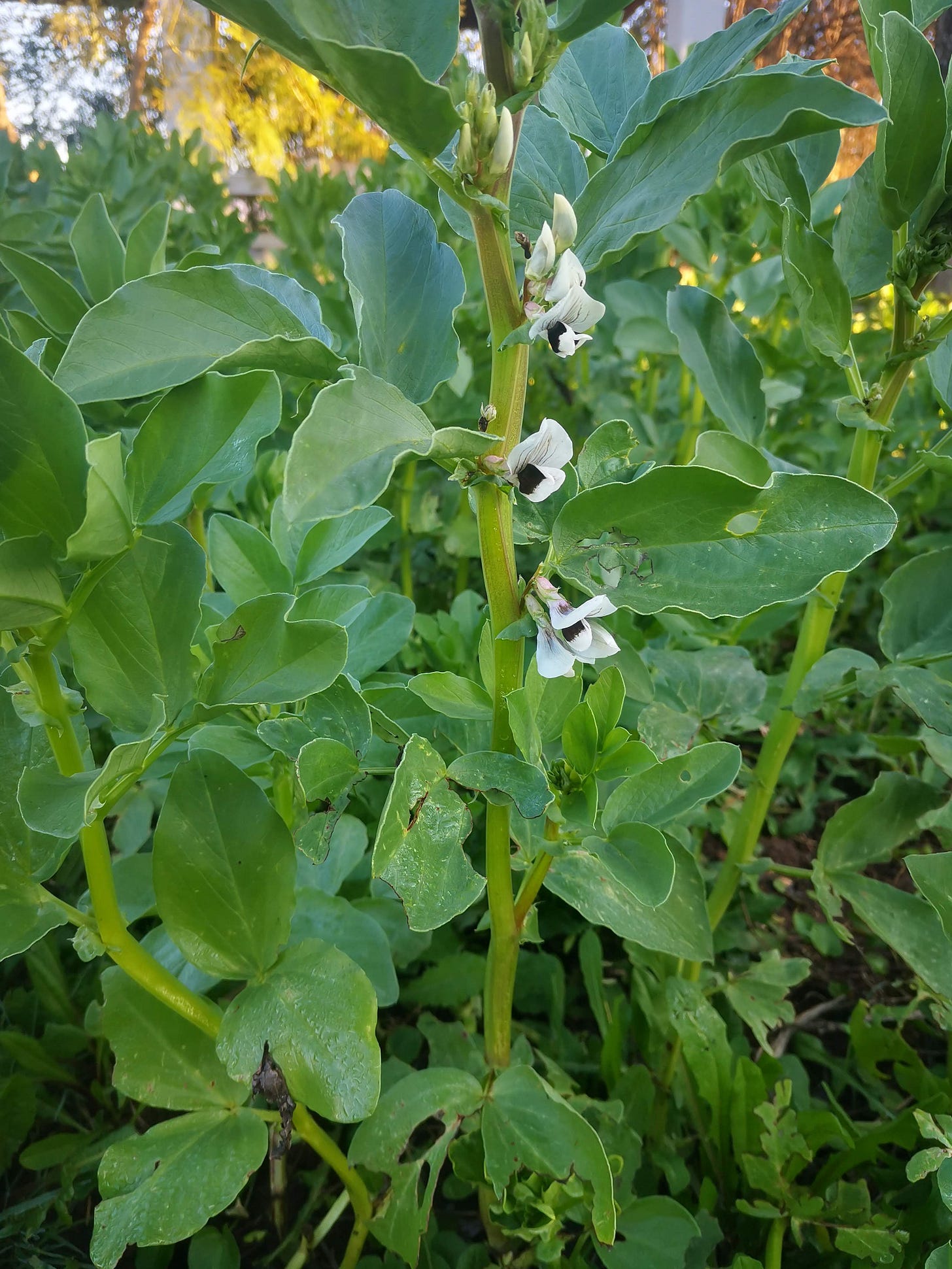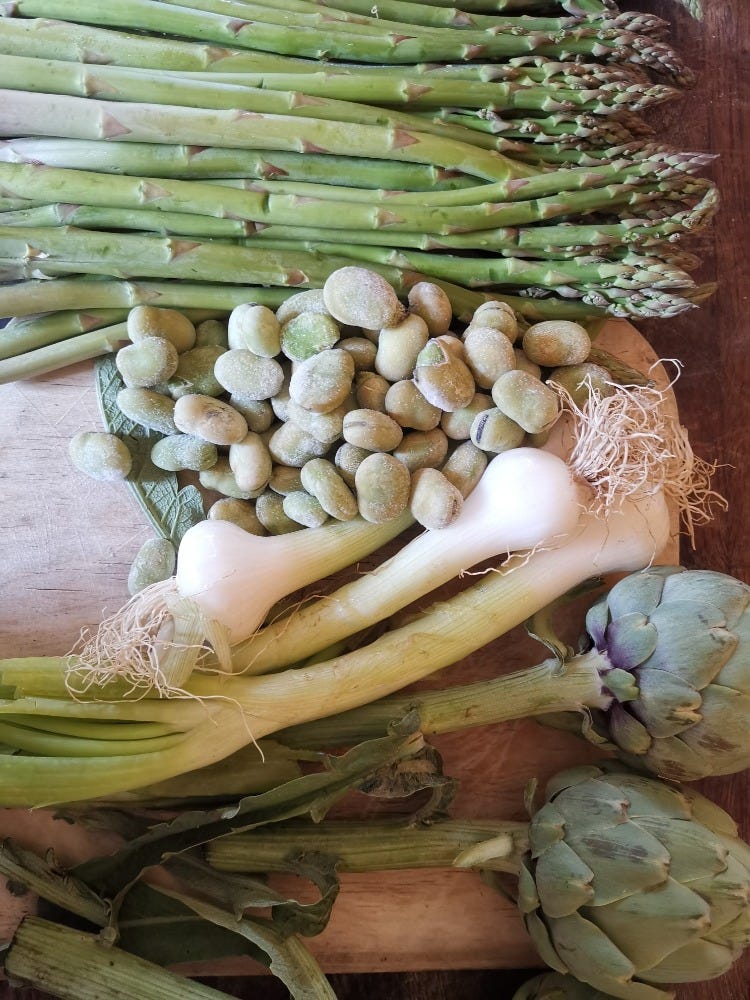I have been thinking about my friend Carla Tomasi a lot this past month. Since March I have been busy preparing for my Spring/Summer garden, a process that has inadvertently left me feeling rather lonely and overwhelmed. Usually I would turn to Carla for her insightful guidance in the garden. She had a pragmatic approach to gardening problems, and I am so glad I saved her dozens and dozens of voice messages telling me what to do when I panicked. She excelled in simplifying complexities. For her, purchasing seedlings from a nursery was far preferable to starting from seed; I am starting to get there myself due to dud seeds. I used to feel so guilty about it, feeling that i can only call myself a real gardeners if everything I grow is from seed to table. It’s bullshit.
Carla usually did not grow peas in her garden due to a persistent battle with aphids. However, she was nothing short of a maestra for artichokes. Her spring cooking classes were renowned for featuring artichokes fresh from her garden—remarkably tender and free of the unpleasant artichoke hair and fuzz, which made them ideal for raw salads.
I miss her presence in both the kitchen and the garden. Carla deeply appreciated convenience, favoring her pasta machine for its efficiency over the laborious task of rolling out dough by hand. She staunchly supported frozen peas, a stance I diverge from, as I enjoy shelling fresh peas and broad beans, for now. Age and arthritis will likely take that pleasure away from me. If she were still alive, I imagine she would be hosting some artichoke cooking class, always including one of Rome's most delicious dishes, Vignarola. It may not be as famous as the carbonara every Italian man promises to make his tinder date but it is a celebration of the Roman spring.
We had big plans to host monthly Sunday wine lunches, but only managed two, and the last one was a most delicious tribute to Palestinian food. This was our way of celebrating Palestine and holding space.
Vignarola—a culinary symbol of the Campagna Romana and its rich history.
Originating from ancient Velletri in the Castelli Romani, the name of this dish has two proposed origins. One theory suggests it relates to "vigna," or vineyards, reflecting the lifestyle of contadini who would enjoy meals outdoors while tending to the vines in spring. Another theory claims that in ancient Rome, vegetable vendors were called vignaroli. Both hold merit, although I recognize that many food writers may lack firsthand experience with the farming practices from which their food come from. I aim to offer my observations grounded in my community, where my neighbors continue cultivating the foods and wines that grace Roman markets. I believe vignarola gets its name because it is made from vegetables grown in the small vineyards these farmers tended to, making use of whatever space they had.
The oldest records I can fine say that this dish originates in Velletri, a city in the Castelli Romani that pre-dates Rome. Even though my address is Genzano, we are right on the border of Velletri, so I see these farming techniques daily.
Before World War II, vignaioli in the Castelli Romani trained their vines high as tendone and pergola vines, allowing for the cultivation of an orto underneath. Peas and broad beans, functioning as companion plants and nitrogen fixers, are still commonly planted in vineyards throughout the Castelli Romani region. It is not unusual for the broad beans to grow nearly as tall as the vines, which require minimal care in their winter dormancy. This symbiotic agricultural practice preserves soil health and creates green compost when mowed down, preventing soil erosion and excessive drying during the summer.
Typically, these small plots encompass about one hectare (10,000 square meters), compelling farmers to maximize every inch by incorporating gardens between rows of vines and olive trees, an approach still employed by many traditional contadini. We often marvel at the wild asparagus that graces our markets in March and April, mistakenly treating it as a rare delicacy, when in reality, it thrives abundantly in our region, particularly flourishing among olive trees. The less the orchards are pruned and mowed, the greater the yield of asparagus.
Artichokes are typically situated at the edges of vineyards, being perennials that return year after year. Following the spring harvest, they are cut back as vineyard work takes precedence, a practice steeped in history in the Castelli Romani and throughout Italy. These remarkable plants have been cultivated in the area for around 2,500 years, possibly longer, with Catherine de' Medici credited for introducing them to France, from where they subsequently spread across Europe, eventually reaching North America via French colonists. I love that link.
Carla was often called the vegetable whisperer. Although she wasn't a vegetarian, she was comfortable in a plant-based kitchen. She knew how to make vegetables exciting and taught her students to bring out the best from local and seasonal products. And there is the real secret. Nothing I ate with Carla was super complicated. She was the quintessential Italian cook. Her focus was on quality, and she taught me the secret to delicious vignarola was the freshness of the vegetables. Of the many times I ate her vignarola, she never used pancetta, even though her recipe below includes it as optional. None of the recipes I have in my old Lazio cookbooks include it either. As she always said, if you have high-quality vegetables, you don't need the pork to "enhance" the flavor; the flavors are already perfect.
I am posting Carla's recipe exactly as she sent it because I find it so charming and endearing. She was honestly one of the best cooks I had the honor to cook with, she did not indulge bullshit, and her recipe makes it so clear to me that she was a cook and not a cookbook writer, and that’s what made her so wonderful. The amount of cooks and cookbook authors she helped and taught throughout her career is uncountable.
Vignarola-spring vegetable stew with peas, broad beans and artichokes a poem by Carla Tomasi
Vignarola is capturing that moment when peas, broad beans and artichokes are at their best and making the most of it because peas are short lived. Artichoke season is quite a long one- October to mid May, broad beans from mid April to end of May and peas usually starts around mid April and run for few weeks. These veggies do not like heat so – apart from exceptionally cool springs- the season for them is a short and sweet one in central and southern Italy but can be adapted and made wherever you may live.
More than a recipe it is an idea that can also be made with other spring offerings if any of the three ( or even more than one) mentioned above is not available. I have made it with peas, ( if young, small and non mealy are around fine, otherwise use frozen- of which I am a big fan) artichokes and asparagus, or I have also used zucchini or I have made vignarola using all the five vegetables.
Purists of Roman cuisine would probably shoot me with a rusty arrows at this point so I better tell you the ingredients of a traditional Vignarola . It is a dish also made in other regions of Italy, called something different and has variations.
Artichokes ,guanciale ( cured pig’s cheek)or pancetta, broad beans, peas, very tender cos lettuce, new season onions ( something a bit more sturdy than spring onions, mint and vegetable broth.
So you start by gently frying in olive oil a couple of chopped up fat spring onions and some finely chopped pig fat. Do not brown. Now you can add your prepared artichokes( if you need a reminder on how to clean artichokes there are plenty of tutorials on YouTube) and if young and tender just stew for ten minutes, then add the shelled peas and broad beans. Add seasoning, give the pan a good mix and just a bit of water or vegetable stock- some people also like to add some wine, Lower the heat, cover with a lid and the vegetables ought to be ready in 20 minutes or so. Then again have a taste after fifteen because you might like your vignarola to be more al dente. When almost ready add some chopped cos lettuce, mix it in and finally a little chopped mint. Few shavings of pecorino just before serving.
It is impossible to give exact cooking time for the whole dish, all I know is that, if your vegetables are fresh and tender , it could take up to 30 minutes to have it ready.
This is what you need to make the vignarola for four people and maybe have some over.
2 large new season onions or very mild white onions
100 gr pancetta totally optional. I only use it if I want to turn vignarola into a pasta sauce
1 or 2 artichokes per person
1 kg broad beans – to be shelled
600 gr fresh peas or 300 gr frozen
1 small head of cos lettuce- very optional
Seasoning-mint- e v olive oil- water or stock – white wine and a bit of mint
During a recent class we made ravioli filled with very finely chopped vignarola ( you can also puree the stuff) ricotta, parmigiano and a touch of nutmeg. Lemon, butter and sage sauce. Quite nice.
Take the time to read these beautiful tributes to Carla.










I think about Carla often and miss her wit & sage advice. I hope someone is taking good care of her lovely garden and her cats are well fed.
I just had surgery on a cancerous lesion on my tongue…in mourning…thank you.